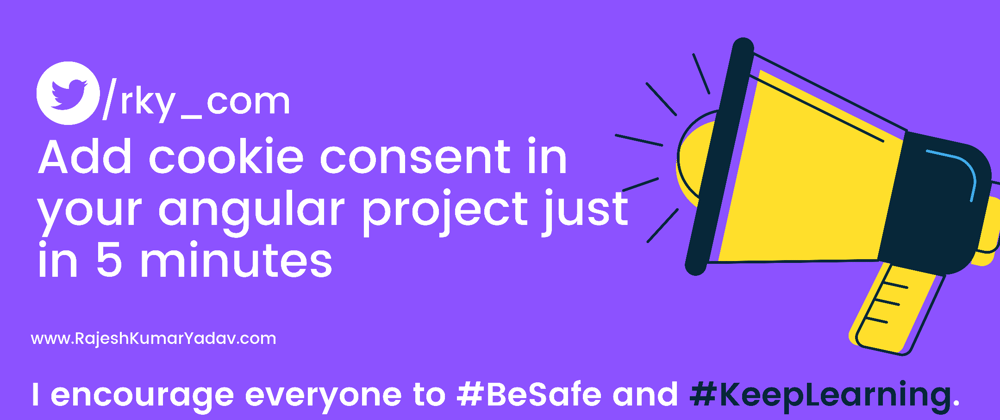Open your terminal and run below command -
npm install --save cookieconsent
Now install ngx-cookieconsent via:
npm install --save ngx-cookieconsent
Once installed you need to import the main module app.module.ts:
import {NgcCookieConsentModule} from 'ngx-cookieconsent';
Add this import to imports of @NgModule on the same file app.module.ts
imports: [NgcCookieConsentModule.forRoot(cookieConfig), ...],
After adding above import in @NgModule your code will look like this-
@NgModule({
declarations: [AppComponent, ...],
imports: [NgcCookieConsentModule.forRoot(cookieConfig), ...],
bootstrap: [AppComponent]
})
Now add below code in the same file app.module.ts -
CODE:
const cookieConfig:NgcCookieConsentConfig = {
cookie: {
domain: 'localhost' // or 'your.domain.com'
},
palette: {
popup: {
background: '#000'
},
button: {
background: '#f1d600'
}
},
theme: 'edgeless',
type: 'opt-out'
};
Once you have done all above steps, your full code for cookie consent will look like this
app.module.ts
// ...
import {NgcCookieConsentModule, NgcCookieConsentConfig} from 'ngx-cookieconsent';
const cookieConfig:NgcCookieConsentConfig = {
cookie: {
domain: 'localhost' // or 'your.domain.com' // it is mandatory to set a domain, for cookies to work properly (see https://goo.gl/S2Hy2A)
},
palette: {
popup: {
background: '#000'
},
button: {
background: '#f1d600'
}
},
theme: 'edgeless',
type: 'opt-out'
};
@NgModule({
declarations: [AppComponent, ...],
imports: [NgcCookieConsentModule.forRoot(cookieConfig), ...],
bootstrap: [AppComponent]
})
export class AppModule {
}
where ... is your existing code.
Now your app module is ready to use cookie consent in your angular application.
Now open that component where you want to add this, in most of the cases any global component you can choose to call cookie consent on each page.
Here is how it works:
app.component.ts
import { Component, OnInit, OnDestroy } from "@angular/core";
import {
NgcCookieConsentService,
NgcNoCookieLawEvent,
NgcInitializeEvent,
NgcStatusChangeEvent,
} from "ngx-cookieconsent";
import { Subscription } from "rxjs";
import { RouterExtService } from "./services/routerurlstate.service";
@Component({
selector: "app-root",
templateUrl: "./app.component.html",
styleUrls: ["./app.component.scss"],
})
export class AppComponent implements OnInit, OnDestroy {
title = "app";
//keep refs to subscriptions to be able to unsubscribe later
private popupOpenSubscription: Subscription;
private popupCloseSubscription: Subscription;
private initializeSubscription: Subscription;
private statusChangeSubscription: Subscription;
private revokeChoiceSubscription: Subscription;
private noCookieLawSubscription: Subscription;
constructor(
private ccService: NgcCookieConsentService,
private routerExtService: RouterExtService
) {
console.log(this.routerExtService.getCurrentUrl());
console.log(this.routerExtService.currentUrl);
}
handleClickSound() {
let x = <HTMLVideoElement>document.getElementById("myAudio");
x.play();
}
ngOnInit() {
// subscribe to cookieconsent observables to react to main events
this.popupOpenSubscription = this.ccService.popupOpen$.subscribe(() => {
// you can use this.ccService.getConfig() to do stuff...
});
this.popupCloseSubscription = this.ccService.popupClose$.subscribe(() => {
// you can use this.ccService.getConfig() to do stuff...
});
this.initializeSubscription = this.ccService.initialize$.subscribe(
(event: NgcInitializeEvent) => {
// you can use this.ccService.getConfig() to do stuff...
}
);
this.statusChangeSubscription = this.ccService.statusChange$.subscribe(
(event: NgcStatusChangeEvent) => {
// you can use this.ccService.getConfig() to do stuff...
}
);
this.revokeChoiceSubscription = this.ccService.revokeChoice$.subscribe(
() => {
// you can use this.ccService.getConfig() to do stuff...
}
);
this.noCookieLawSubscription = this.ccService.noCookieLaw$.subscribe(
(event: NgcNoCookieLawEvent) => {
// you can use this.ccService.getConfig() to do stuff...
}
);
}
ngOnDestroy() {
// unsubscribe to cookieconsent observables to prevent memory leaks
this.popupOpenSubscription.unsubscribe();
this.popupCloseSubscription.unsubscribe();
this.initializeSubscription.unsubscribe();
this.statusChangeSubscription.unsubscribe();
this.revokeChoiceSubscription.unsubscribe();
this.noCookieLawSubscription.unsubscribe();
}
}
Then run ng server command and you will see cookie consent working on your page.
Extra Bits-
If you have multiple domain or you are testing on subdomain and then want to deploy to actual domain then in this case you can make the domain dynamic -
CODE:
cookie: { domain: window.location.hostname, },
Demo - https://rajeshkumaryadav.com
With all that being said, I highly recommend you keep learning!
Thank you for reading this article. Please feel free to connect with me on LinkedIn and Twitter.




















